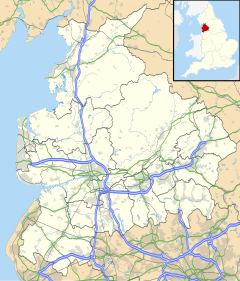Harle Syke
| Harle Syke | |
|---|---|
 Oxford Mill, part of Harle Syke Mill |
|
| Harle Syke shown within Lancashire | |
| OS grid reference | SD864350 |
| Civil parish | |
| District | |
| Shire county | |
| Region | |
| Country | England |
| Sovereign state | United Kingdom |
| Post town | BURNLEY |
| Postcode district | BB10 |
| Dialling code | 01282 |
| Police | Lancashire |
| Fire | Lancashire |
| Ambulance | North West |
| EU Parliament | North West England |
| UK Parliament | |
Harle Syke is a small village within the parish of Briercliffe, situated three miles north of Burnley, Lancashire, England. It was the home to eleven weaving firms, working out of seven mills. Queen Street Mill closed in 1982, and was converted to a textile museum, preserving it as a working mill. It is the world's last 19th-century steam powered weaving mill.
Harle Syke lies at the edge of the Burnley urban area connecting it to the village of Haggate. The main road climbs from the Burnley border to the small crossroads in Haggate, with a road between Nelson and Todmorden. The village dates from the late 19th century, when most of the weaving mills were built.
The origins of the name Harle Syke, first used for a farm nearby, are descriptive; Harle is a person's name, while sike or syke is a local word meaning 'ditch'.
The village itself is relatively flat rising to 800 feet above sea level. To the south is the valley of the River Don or Thursden Brook and to the north is hill of Marsden Height, (270 metres (886 ft)) in Brierfield. The buildings in the village are predominantly stone-built.
All the public houses are open as of 2015, and it has a social club (Briercliffe Social Club). There is a Church of England church.
Harle Ayke has direct road links with Burnley and Nelson, and is served by local bus services (4,5) operated by Transdev in Burnley & Pendle.
Briercliffe was named in the Charter of Freewarren granted to Edmund de Lacy the Lord of Blackburnshire in 1251, allowing him to use the area for hunting hares, rabbits and foxes.
...
Wikipedia

